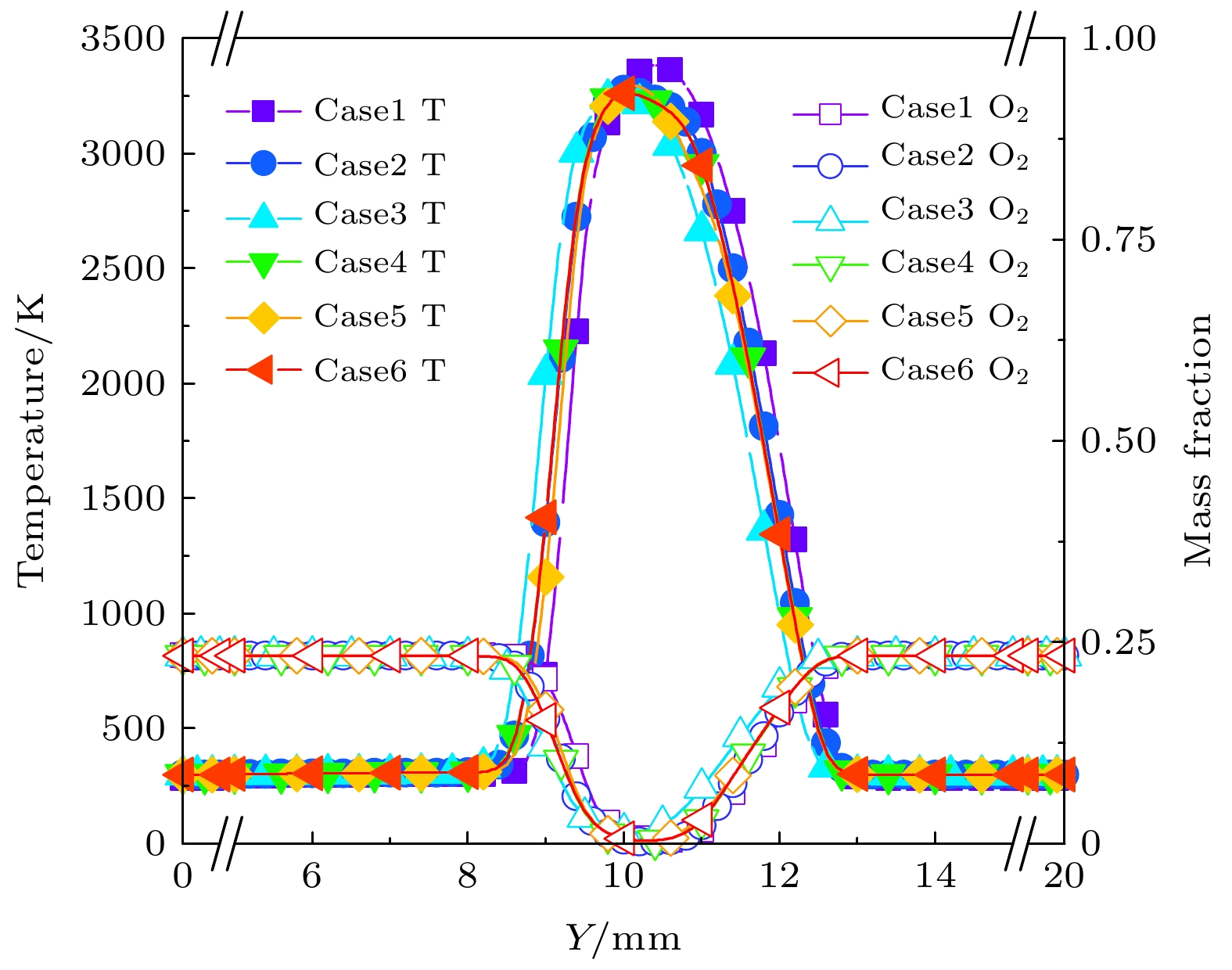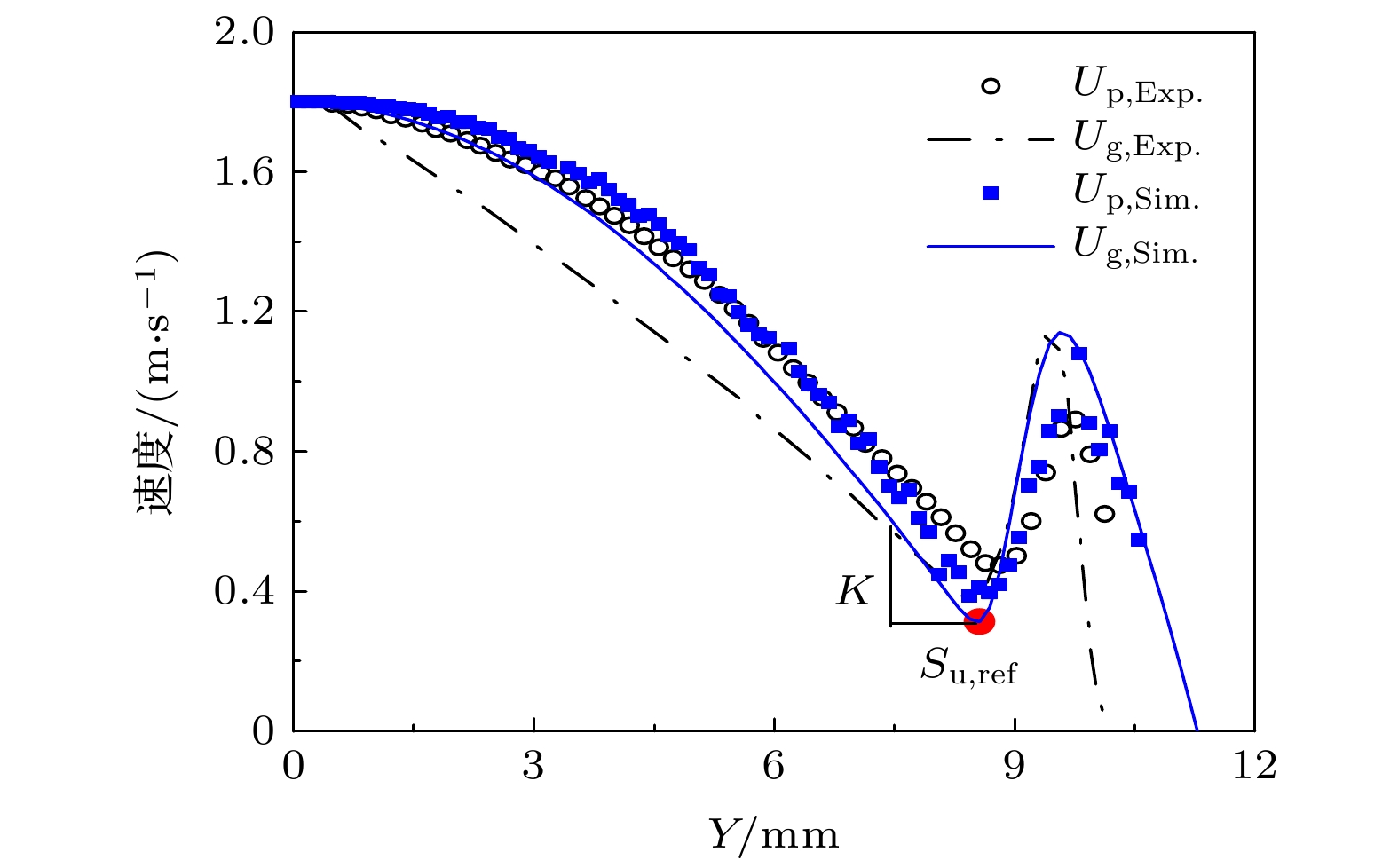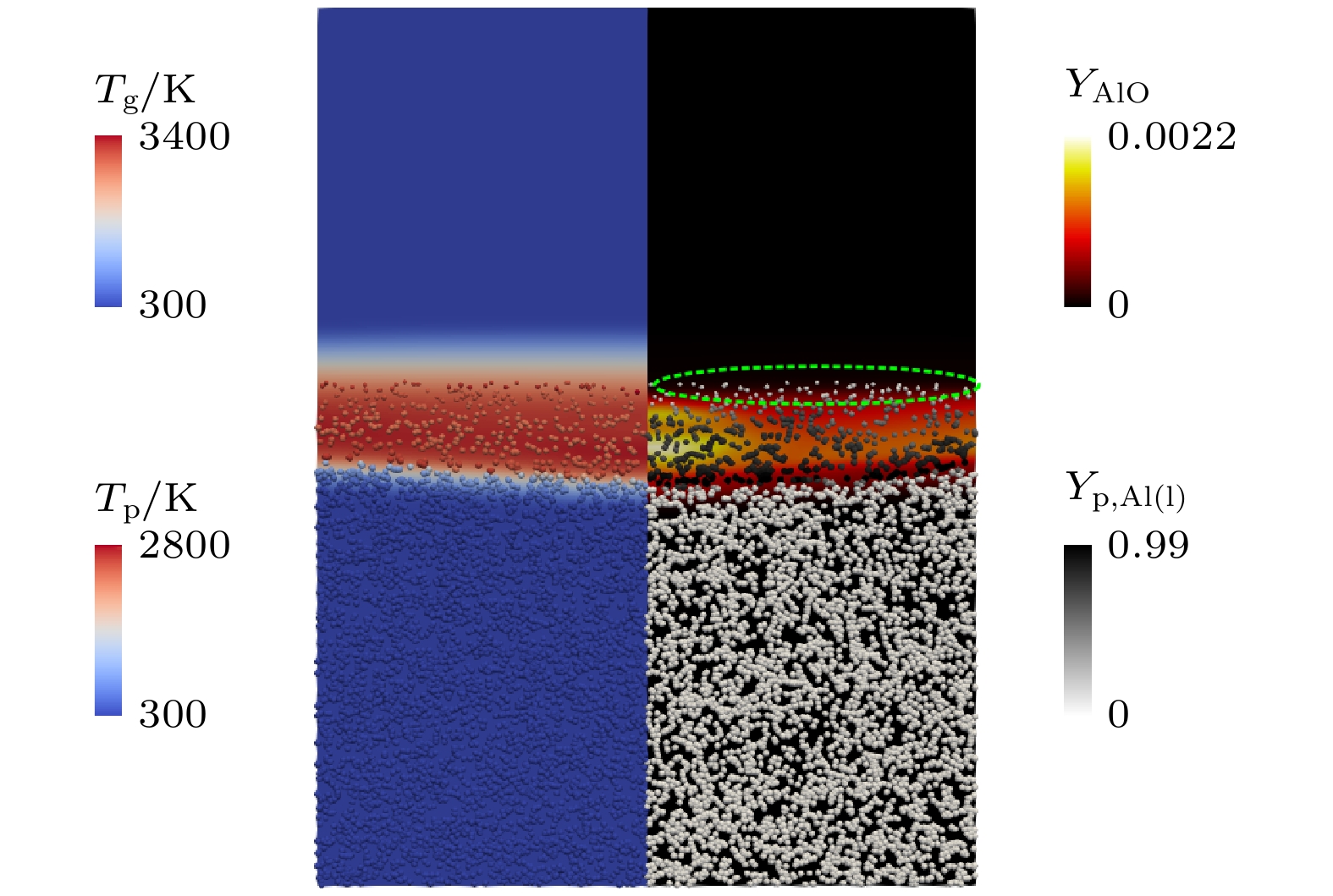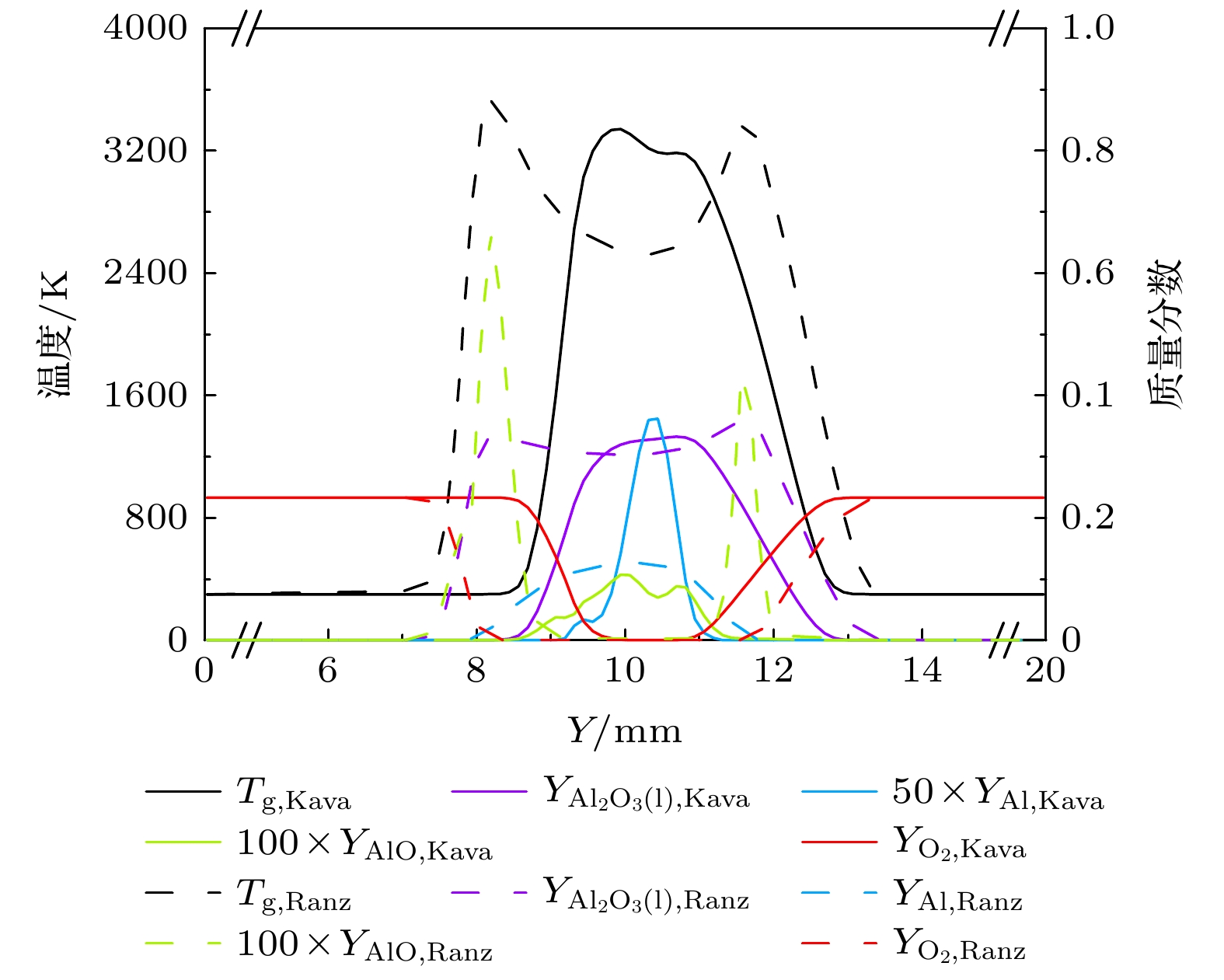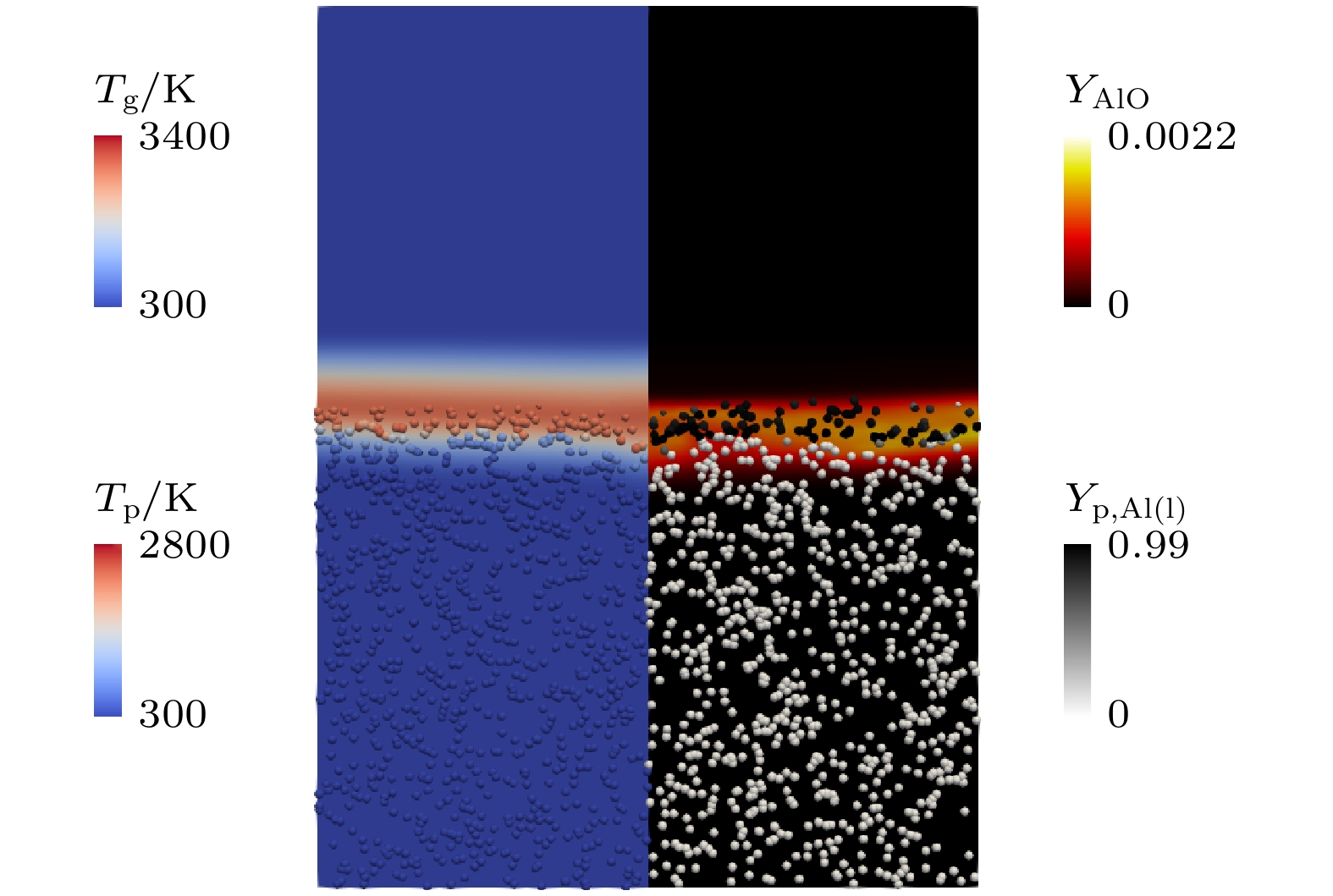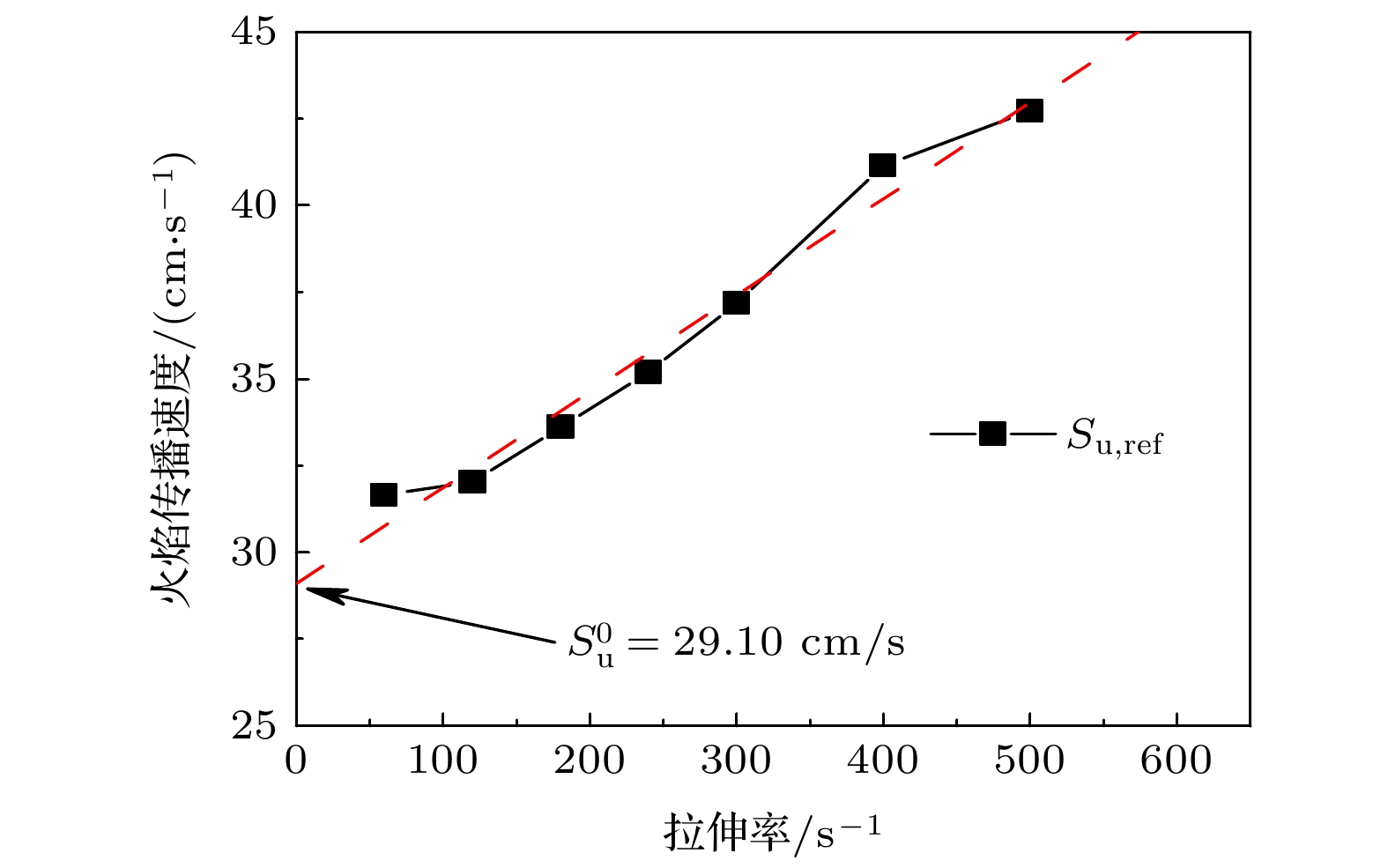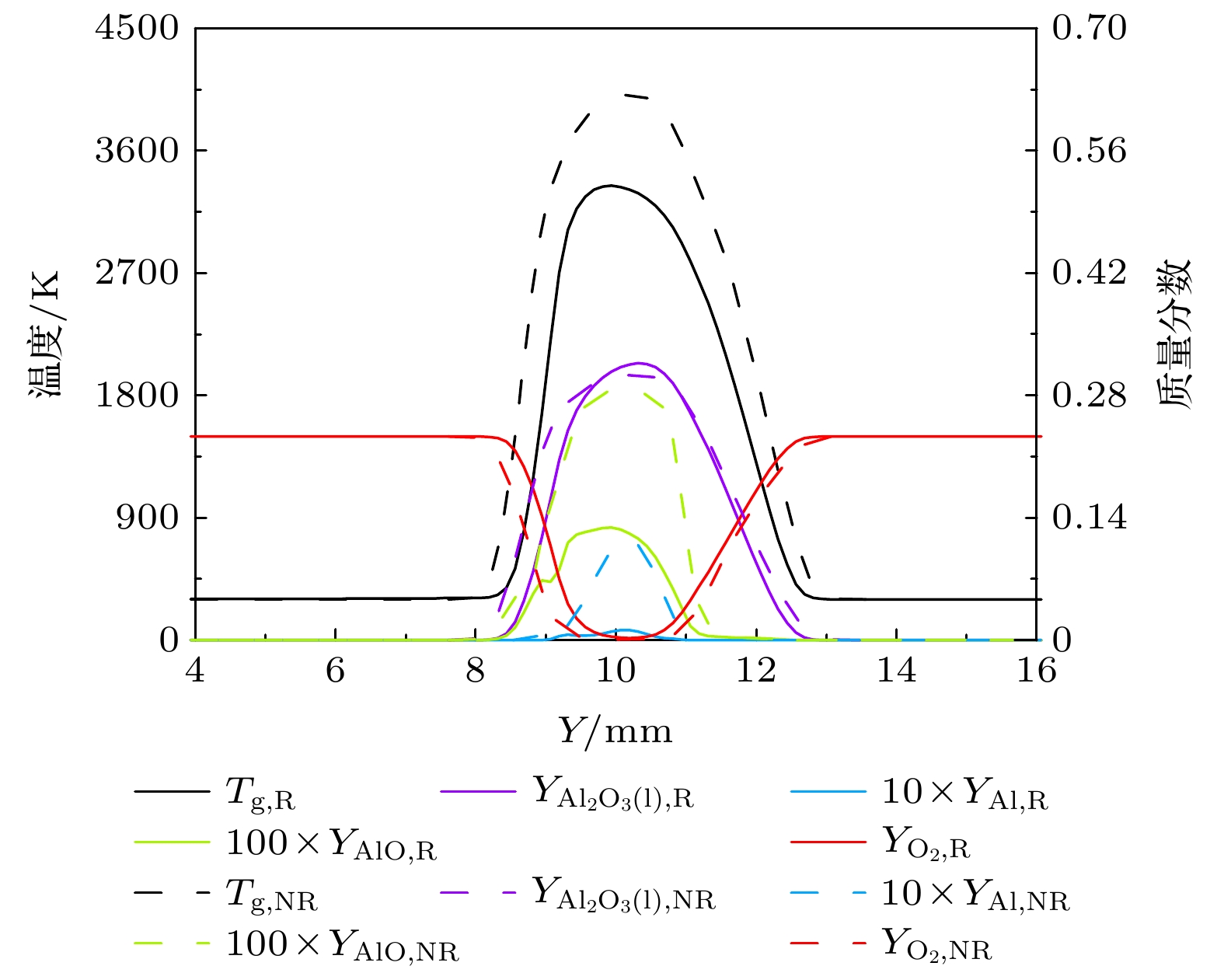-
铝颗粒由于具有能量密度高、易储存、燃烧过程不产生温室气体等优势, 有望成为未来化石燃料替代的解决方案. 本文建立了铝颗粒粉尘火焰的燃烧模型, 其中考虑了相间传热、相变、表面化学反应、气相详细化学反应及辐射传热等过程, 并针对铝颗粒粉尘对冲火焰开展了数值模拟研究. 首先, 通过仿真McGill大学的铝颗粒粉尘对冲火焰实验进行模型验证, 并分析了实验中使用铝颗粒本身作为示踪粒子引起的气相速度测量误差, 结果表明, 数值模拟得到的离散相速度分布与实验结果基本一致, 火焰传播速度的预测值也同实验数据吻合较好. 当颗粒粒径小于10 μm时, 连续介质假设不再成立, 相间传热模型必须考虑过度区机制, 随着颗粒粒径的增加, 火焰传播速度不断降低. 随着对冲火焰拉伸率的增加, 颗粒在火焰区的停留时间减少, 并出现燃烧不完全的现象, 粉尘火焰由双峰变为单峰结构. 火焰传播速度随着拉伸率的增加而增大, 通过线性外推可得到未拉伸的火焰传播速率约为29 cm/s. 辐射引起的热损失会导致气相温度大幅降低, 但辐射传热对颗粒的加热作用相对较小.
Aluminum is widely used as an additive in solid rocket propellants and pyrotechnics due to its outstanding characteristics such as high energy density and combustion temperature, environmentally benign products, and good stability. Recently, aluminum powders are found to present great potential serving as alternative fuel in a low-carbon economy. In this paper, a detailed model including the effects of interphase heat transfer, phase change, heterogeneous surface reactions, homogeneous combustion and radiation is employed to investigate aluminum dust counterflow flames. The numerical model is first validated by simulating the aluminum dust counterflow flames of McGill University. The results indicate that the particle velocity profile is in very good agreement with the experimental measurements. A detailed analysis of estimating the gas phase velocity based on the particle velocity is performed by using Stoke time τs. The results show that a correct value of τs is the key to this method, and using a single value of τs can bring a notable bias to the results, which may also affect the evaluation of flame speed from the counterflow flame. It is suggested that model validation should be carried out by directly comparing the particle velocity profiles from the simulations with those from the experiments. The flame structure of the aluminum dust counterflow flame is discussed, and the interphase heat transfer model is found to have a great influence on the flame for particle sizes smaller than 10 μm. Therefore, when simulating the aluminum dust flames with small particle sizes, the interphase heat transfer model should be selected carefully so that it can cover the transition heat transfer regime. The effect of particle diameter is examined. With the increase of the particle size, the flame speed continues to decrease, and most particles with a diameter of 15 μm cannot be fully burnt in the present configuration. The strain rate is found to be an important factor affecting the dust flame. As the strain rate increases, the residence time of the particles in the flame zone decreases, which ultimately leads the particles to be combusted incompletely. Moreover, the reaction zone of the counterflow flame, marked as AlO, is observed to be shrunk from a large double-peak structure into a small single-peak one along the burner centerline when strain increases. The reference flame speed increases with strain rate, and an unstretched reference flame speed of roughly 29 cm/s can be obtained by linear extrapolation of the predicted results. The effect of radiation is investigated by comparing two cases with and without radiative heat transfer. The results show that the heat loss caused by radiation can lead the temperature to decrease greatly in the gas phase, but the heating effect on the particles by radiation is relativelysmall. -
Keywords:
- aluminum combustion /
- counterflow flame /
- particle clouds /
- flame speed
[1] 王宁飞, 苏万兴, 李军伟, 张峤 2011 固体火箭技术 34 61
 Google Scholar
Google Scholar
Wang N F, Sun W X, Li J W, Zhang Q 2011 J. Solid Rocket Technol. 34 61
 Google Scholar
Google Scholar
[2] 李潮隆, 夏智勋, 马立坤, 赵翔, 罗振兵, 段一凡 2021 航空学报 40 26075
Li C L, Xia Z X, Ma L K, Zhao X, Luo Z B, Duan Y F 2021 Acta Aeronaut. Astronaut. Sin. 40 26075
[3] 王德全, 夏智勋, 胡建新 2010 航空学报 31 1074
Wang D Q, Xia Z X, Hu J X 2010 Acta Aeronaut. Astronaut. Sin. 31 1074
[4] 刘龙, 夏智勋, 黄利亚, 马立坤, 陈斌斌 2020 69
 Google Scholar
Google Scholar
Liu L, Xia Z X, Huang L Y, Ma L K, Chen B B 2020 Acta Phys. Sin. 69
 Google Scholar
Google Scholar
[5] 杨晋朝, 夏智勋, 胡建新 2013 62 074701
 Google Scholar
Google Scholar
Yang J Z, Xia Z X, Hu J X 2013 Acta Phys. Sin. 62 074701
 Google Scholar
Google Scholar
[6] Zhang J, Xia Z, Ma L, Huang L, Feng Y, Yang D 2021 Energy 214 118889
 Google Scholar
Google Scholar
[7] Bergthorson J M 2018 Prog. Energy Combust. Sci. 68 169
 Google Scholar
Google Scholar
[8] Goroshin S, Mamen J, Higgins A, Bazyn T, Glumac N, Krier H 2007 Proc. Combust. Inst. 31 2011
 Google Scholar
Google Scholar
[9] Lomba R, Laboureur P, Dumand C, Chauveau C, Halter F 2019 Proc. Combust. Inst. 37 3143
 Google Scholar
Google Scholar
[10] Xu W, Jiang Y 2018 Energies 11 3147
 Google Scholar
Google Scholar
[11] 邓哲 2016 博士学位论文 (西安: 西北工业大学)
Deng Z 2016 Ph. D. Dissertation (Xi’an: Northwestern Polytechnical University) (in Chinese)
[12] Risha G, Huang Y, Yetter R, Yang, V 2005 Proceedings of the 43 rd AIAA Aerospace Sciences Meeting and Exhibit Reno, USA, January 10–13, 2005
[13] Goroshin S, Fomenko I, Lee J H S 1996 Symp. (Int.) Combust. 26 1961
 Google Scholar
Google Scholar
[14] Julien P, Whiteley S, Soo M, Goroshin S, Frost D, Bergthorson J 2017 Proc. Combust. Inst. 36 2291
 Google Scholar
Google Scholar
[15] Julien P, Vickery J, Goroshin S, Frost D, Bergthorson J 2015 Combust. Flame 162 4241
 Google Scholar
Google Scholar
[16] Egolfopoulos F N, Hansen N, Ju Y, Kohse-Höinghaus K, Law C, Qi F 2014 Prog. Energy Combust. Sci. 43 36
 Google Scholar
Google Scholar
[17] Huang Y, Risha G A, Yang V, Yetter R 2009 Combust. Flame 156 5
 Google Scholar
Google Scholar
[18] Escot Bocanegra P, Davidenko D, Sarou-Kanian V, Chauveau C, Gökalp I 2010 Exp. Therm. Fluid Sci. 34 299
 Google Scholar
Google Scholar
[19] Han D, Sung H 2019 Combust. Flame 206 112
 Google Scholar
Google Scholar
[20] Zou X, Wang N, Wang J, Feng Y, Shi B 2021 Aerosp. Sci. Technol. 112 106604
 Google Scholar
Google Scholar
[21] Zou X, Wang N, Liao L, Chu Q, Shi B 2020 Fuel 266 116952
 Google Scholar
Google Scholar
[22] Khalili H, Madani S, Mohammadi M, Poorfar, A, Bidabadi M, Pendleton P, 2019 Combust. Explos. Shock Waves 55 65
 Google Scholar
Google Scholar
[23] Najjar F, Ferry J, Haselbacher A, Balachandar S 2006 J. Spacecraft Rockets 43 1258
 Google Scholar
Google Scholar
[24] 刘平安, 常浩, 李树声, 王文超 2018 固体火箭技术 41 156
Liu P A, Chang H, Li S S, Wang W H 2018 J. Solid Rocket Technol. 41 156
[25] Li C, Xia Z, Ma L, Chen B 2019 Energies 12 1235
 Google Scholar
Google Scholar
[26] Li C, Xia Z, Ma L, Chen B 2019 Acta Astronaut. 162 145
 Google Scholar
Google Scholar
[27] Yuen M, Chen L W 1976 Combust. Sci. Technol. 14 147
 Google Scholar
Google Scholar
[28] Ranz W, Marshall W 1952 Chem. Eng. Prog. 48 141
[29] Mohan S, Trunov M, Dreizin E 2008 J. Heat Transfer 130 104505
 Google Scholar
Google Scholar
[30] Crowe C, Schwarzkopf J, Sommerfeld M, Tsuji Y 2011 Multiphase flows with droplets and particles (2nd Ed.) (Boca Raton: CRC Press) p106
[31] Chase Mhttps://janaf.nist.gov/ [2020-9-6]
[32] Gurevich M, Ozerova G, Stepanov A 1970 Combust. Explos. Shock Waves 6 291
 Google Scholar
Google Scholar
[33] Glorian J, Gallier S, Catoire L 2016 Combust. Flame 168 378
 Google Scholar
Google Scholar
[34] Harrison J, Brewster M 2009 J. Thermophys. Heat Transfer 23 630
 Google Scholar
Google Scholar
[35] Modest M 2013 Radiative Heat Transfer (3rd Ed.) (Amsterdam: Academic Press) p26
[36] Lynch P, Krier H, Glumac N 2010 J. Thermophys. Heat Transfer 24 301
 Google Scholar
Google Scholar
[37] Munzar J, Akih-Kumgeh B, Denman B, Zia A, Bergthorson J 2013 Fuel 113 586
 Google Scholar
Google Scholar
-
图 11 不同平均拉伸率(SR)下对冲火焰的时均气相温度(左)和AlO分布(右)和铝颗粒粉尘分布. 颗粒浓度: 500 g/m3, 颗粒直径: 5.6 μm
Fig. 11. Time-averaged gas temperature and AlO mass fraction fields and instantaneous particle clouds of the counterflow flame under different average strain rates (SR). Dust concentration: 500 g/m3, particle diameter: 15 μm.
表 1 铝-空气详细化学反应机理
Table 1. Al/O2 gas-phase mechanism.
编号 基元反应 A/(cm3·mol–1·s–1) n E/(cal·mol–1) 1 Al + O2 = AlO + O 9.72 × 1013 0 159.95 2 Al + O + M = AlO + M 3.0 × 1017 –1.0 0 3 AlO + O2 = OAlO + O 4.62 × 1014 0 19885.9 4 Al2O3 = AlOAlO + O 3.0 × 1015 0 97649.99 5 Al2O3 = OAlO + AlO 3.0 × 1015 0 126999.89 6 AlOAlO = AlO + AlO 1.0 × 1015 0 117900 7 AlOAlO = Al + OAlO 1.0 × 1015 0 148900 8 AlOAlO = AlOAl + O 1.0 × 1015 0 104249.94 9 OAlO = AlO + O 1.0 × 1015 0 88549.86 10 AlOAl = AlO + Al 1.0 × 1015 0 133199.94 11 Al2O3 = Al2O3(l) 1.0 × 1014 0 0 表 2 网格分辨率及时间步长敏感性分析算例
Table 2. Case setups for mesh resolution and time step sensitivity investigations.
No. 网格分辨率/μm 时间步长/s 计算域维数 Case 1 125 1 × 10–6 3 Case 2 125 1 × 10–6 2 Case 3 167 1 × 10–6 2 Case 4 100 1 × 10–6 2 Case 5 125 1.2 × 10–6 2 Case 6 125 5 × 10–7 2 -
[1] 王宁飞, 苏万兴, 李军伟, 张峤 2011 固体火箭技术 34 61
 Google Scholar
Google Scholar
Wang N F, Sun W X, Li J W, Zhang Q 2011 J. Solid Rocket Technol. 34 61
 Google Scholar
Google Scholar
[2] 李潮隆, 夏智勋, 马立坤, 赵翔, 罗振兵, 段一凡 2021 航空学报 40 26075
Li C L, Xia Z X, Ma L K, Zhao X, Luo Z B, Duan Y F 2021 Acta Aeronaut. Astronaut. Sin. 40 26075
[3] 王德全, 夏智勋, 胡建新 2010 航空学报 31 1074
Wang D Q, Xia Z X, Hu J X 2010 Acta Aeronaut. Astronaut. Sin. 31 1074
[4] 刘龙, 夏智勋, 黄利亚, 马立坤, 陈斌斌 2020 69
 Google Scholar
Google Scholar
Liu L, Xia Z X, Huang L Y, Ma L K, Chen B B 2020 Acta Phys. Sin. 69
 Google Scholar
Google Scholar
[5] 杨晋朝, 夏智勋, 胡建新 2013 62 074701
 Google Scholar
Google Scholar
Yang J Z, Xia Z X, Hu J X 2013 Acta Phys. Sin. 62 074701
 Google Scholar
Google Scholar
[6] Zhang J, Xia Z, Ma L, Huang L, Feng Y, Yang D 2021 Energy 214 118889
 Google Scholar
Google Scholar
[7] Bergthorson J M 2018 Prog. Energy Combust. Sci. 68 169
 Google Scholar
Google Scholar
[8] Goroshin S, Mamen J, Higgins A, Bazyn T, Glumac N, Krier H 2007 Proc. Combust. Inst. 31 2011
 Google Scholar
Google Scholar
[9] Lomba R, Laboureur P, Dumand C, Chauveau C, Halter F 2019 Proc. Combust. Inst. 37 3143
 Google Scholar
Google Scholar
[10] Xu W, Jiang Y 2018 Energies 11 3147
 Google Scholar
Google Scholar
[11] 邓哲 2016 博士学位论文 (西安: 西北工业大学)
Deng Z 2016 Ph. D. Dissertation (Xi’an: Northwestern Polytechnical University) (in Chinese)
[12] Risha G, Huang Y, Yetter R, Yang, V 2005 Proceedings of the 43 rd AIAA Aerospace Sciences Meeting and Exhibit Reno, USA, January 10–13, 2005
[13] Goroshin S, Fomenko I, Lee J H S 1996 Symp. (Int.) Combust. 26 1961
 Google Scholar
Google Scholar
[14] Julien P, Whiteley S, Soo M, Goroshin S, Frost D, Bergthorson J 2017 Proc. Combust. Inst. 36 2291
 Google Scholar
Google Scholar
[15] Julien P, Vickery J, Goroshin S, Frost D, Bergthorson J 2015 Combust. Flame 162 4241
 Google Scholar
Google Scholar
[16] Egolfopoulos F N, Hansen N, Ju Y, Kohse-Höinghaus K, Law C, Qi F 2014 Prog. Energy Combust. Sci. 43 36
 Google Scholar
Google Scholar
[17] Huang Y, Risha G A, Yang V, Yetter R 2009 Combust. Flame 156 5
 Google Scholar
Google Scholar
[18] Escot Bocanegra P, Davidenko D, Sarou-Kanian V, Chauveau C, Gökalp I 2010 Exp. Therm. Fluid Sci. 34 299
 Google Scholar
Google Scholar
[19] Han D, Sung H 2019 Combust. Flame 206 112
 Google Scholar
Google Scholar
[20] Zou X, Wang N, Wang J, Feng Y, Shi B 2021 Aerosp. Sci. Technol. 112 106604
 Google Scholar
Google Scholar
[21] Zou X, Wang N, Liao L, Chu Q, Shi B 2020 Fuel 266 116952
 Google Scholar
Google Scholar
[22] Khalili H, Madani S, Mohammadi M, Poorfar, A, Bidabadi M, Pendleton P, 2019 Combust. Explos. Shock Waves 55 65
 Google Scholar
Google Scholar
[23] Najjar F, Ferry J, Haselbacher A, Balachandar S 2006 J. Spacecraft Rockets 43 1258
 Google Scholar
Google Scholar
[24] 刘平安, 常浩, 李树声, 王文超 2018 固体火箭技术 41 156
Liu P A, Chang H, Li S S, Wang W H 2018 J. Solid Rocket Technol. 41 156
[25] Li C, Xia Z, Ma L, Chen B 2019 Energies 12 1235
 Google Scholar
Google Scholar
[26] Li C, Xia Z, Ma L, Chen B 2019 Acta Astronaut. 162 145
 Google Scholar
Google Scholar
[27] Yuen M, Chen L W 1976 Combust. Sci. Technol. 14 147
 Google Scholar
Google Scholar
[28] Ranz W, Marshall W 1952 Chem. Eng. Prog. 48 141
[29] Mohan S, Trunov M, Dreizin E 2008 J. Heat Transfer 130 104505
 Google Scholar
Google Scholar
[30] Crowe C, Schwarzkopf J, Sommerfeld M, Tsuji Y 2011 Multiphase flows with droplets and particles (2nd Ed.) (Boca Raton: CRC Press) p106
[31] Chase Mhttps://janaf.nist.gov/ [2020-9-6]
[32] Gurevich M, Ozerova G, Stepanov A 1970 Combust. Explos. Shock Waves 6 291
 Google Scholar
Google Scholar
[33] Glorian J, Gallier S, Catoire L 2016 Combust. Flame 168 378
 Google Scholar
Google Scholar
[34] Harrison J, Brewster M 2009 J. Thermophys. Heat Transfer 23 630
 Google Scholar
Google Scholar
[35] Modest M 2013 Radiative Heat Transfer (3rd Ed.) (Amsterdam: Academic Press) p26
[36] Lynch P, Krier H, Glumac N 2010 J. Thermophys. Heat Transfer 24 301
 Google Scholar
Google Scholar
[37] Munzar J, Akih-Kumgeh B, Denman B, Zia A, Bergthorson J 2013 Fuel 113 586
 Google Scholar
Google Scholar
计量
- 文章访问数: 7989
- PDF下载量: 113
- 被引次数: 0













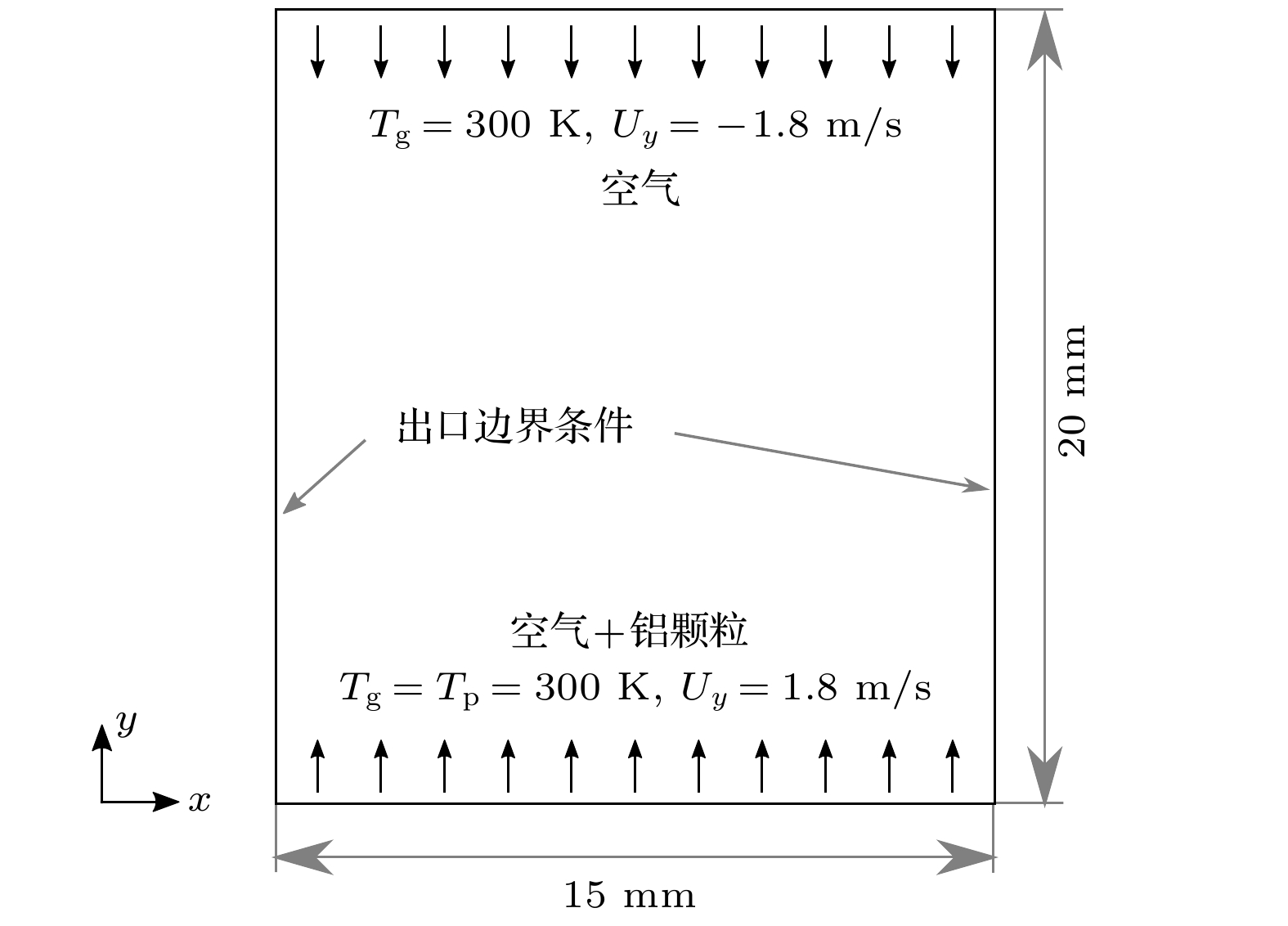
 下载:
下载:
